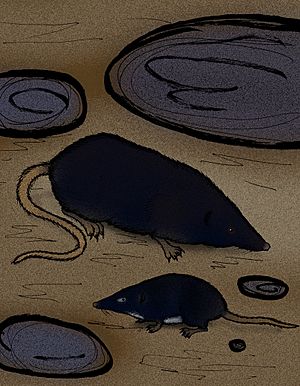Balearic shrew facts for kids
Quick facts for kids Balearic shrew |
|
|---|---|
 |
|
| Comparison of N. hidalgo, and a water shrew | |
| Conservation status | |
| Scientific classification | |
| Genus: |
Nesiotites
|
| Species: |
hidalgo
|
| Synonyms | |
|
Asoriculus hidalgo |
|
The Balearic shrew (Nesiotites hidalgo) was a type of shrew that is now extinct. It lived on the islands of Majorca and Menorca. These islands are part of the Balearic Islands in Spain.
This shrew belonged to a special group of animals called Nesiotites. This group was unique to the Balearic Islands. The Balearic shrew was one of only three native land mammals there. The others were Myotragus and Hypnomys.
Nesiotites shrews have lived on the Balearic Islands for a very long time. They have been there for over 5 million years. The Balearic shrew was the last and largest type in its family line. It was quite big for a shrew, weighing about 20 to 30 grams.
Scientists believe it was most closely related to the Himalayan shrew. They think these two animals separated about 6.44 million years ago. The Balearic shrew might also be related to another extinct shrew group called Asoriculus. This group lived in mainland Europe and on Corsica-Sardinia.
See also
 In Spanish: Nesiotites hidalgo para niños
In Spanish: Nesiotites hidalgo para niños

